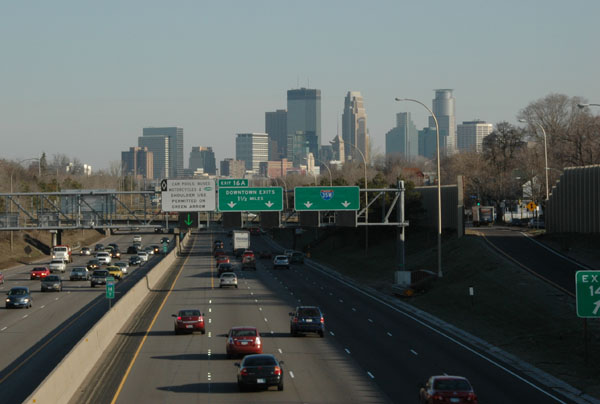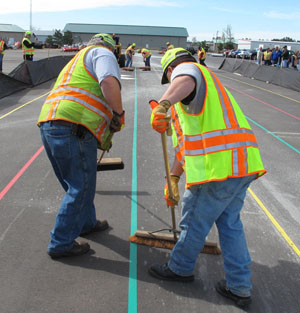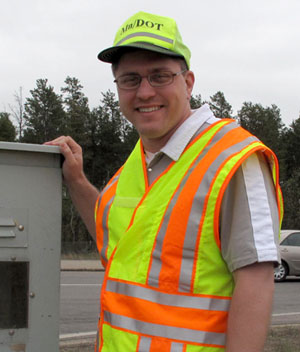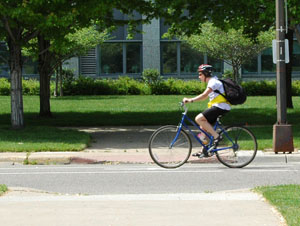 |
|

|
 |
TABLE of CONTENTS
 |
Work progresses on Crosstown reconstruction, I-94 resurfacing |

(Pictured above) Crews work on a stretch of Hwy 62 just east of Penn Avenue in Richfield.
The work is part of a massive multi-year, $288 million project that involves the reconstruction of the I-35W/Hwy 62 commons area, as well as segments of both roads that lead into the area. All roadwork is expected to be complete by the end of the year, with the entire project slated for completion in June 2011.
Upon completion, the project will:
- Increase road capacity and provide safer driving conditions for motorists
- Create neighborhood benefits by reducing traffic diversions to local streets
- Provide high-occupancy vehicle lanes to support transit on I-35W
- Minimize additional right of way takings while balancing impacts on adjacent properties
For more information on the I-35/Hwy 62 Crosstown reconstruction project, visit http://www.dot.state.mn.us/projects/crosstown/index.html.
I-94 resurfacing project in St. Paul underway
Traveling on I-94 between Hwy 280 and Western Avenue in St. Paul is going to be a little more challenging than usual this summer. On May 10, Crews began a rehabilitation project that calls for resurfacing the highway and all ramps to and from I-94. The project also includes drainage improvements, bridge maintenance work, shoulder reconstruction and lane realignment.
This project is the first phase of a two-phase project to improve I-94 between downtown St. Paul and downtown Minneapolis. Work on phase one is expected to be complete by late August.
For more information on the project, visit http://www.dot.state.mn.us/metro/projects/i94resurfacing/index.html. Photo by David Gonzalez |
|
 |
|

|
 |
TABLE of CONTENTS
 |
Bridge prioritization, design-build changes among transportation issues addressed in 2010 session |
By Erik Rudeen, Government Affairs While the Legislature passed a capital bonding bill early in the session that would fund nearly $140 million in Mn/DOT-related projects, much of the final work of the 2010 session wasn’t completed until a one-day special session on Monday, May 17.
A number of transportation-related provisions were enacted this year, including:
Bridge prioritization—Establishes a prioritization system for trunk highway bridges starting in 2018 (after the completion of the Chapter 152 bridge program). It expands the current planning process to include risk-based criteria for scheduling bridge repairs and replacements.
Design-build stipends—Requires Mn/DOT to pay stipends to design-build proposers if their proposals are responsive in every way except that they exceed the price cap. Mn/DOT is including a price cap in the Hastings Bridge design-build project, and the current law may limit competition. The stipend covers approximately 25 percent to 30 percent of a bidder’s cost for submitting a proposal. Bidders may be unwilling to bid on a project if there is a risk of not receiving the stipend to offset their costs.
Reissue of design-build request for proposals—Allows Mn/DOT to reissue a design-build request for proposals only to short-listed teams if all bids are rejected or if the contract is not executed, and to pay a “reasonable” fee to each proposer. This allows Mn/DOT to re-issue the RFP, saving the department significant time and cost. Mn/DOT would not have to reissue the request for qualifications and design-build contractors would not have to spend time and effort preparing responses to the RFQ.
Innovative finance—Allows Mn/DOT to conduct one pilot project using federal assistance through the Transportation Infrastructure Finance and Innovation Act, national transportation infrastructure bank, or other federal transportation loan, grant or credit assistance programs. Such assistance may include but is not limited to loans, loan guarantees and lines of credit. Mn/DOT would report to the Legislature after a project is completed under this authority.
Quick clearance—Gives Mn/DOT and the State Patrol—in conjunction with private towing and recovery companies—authority to clear vehicles and cargo that block roadways in the Twin Cities area after collisions or spilled loads. Crashes, rollovers or jack-knifed commercial vehicles with spilled loads often block lanes of traffic for several hours before they are cleared. When this occurs in the Twin Cities area, severe congestion can result and thousands of motorists are delayed, and the probability of secondary crashes is high.
Rest areas—Makes it illegal to litter or dump household trash at rest areas. Also stipulates that trailers/recreational vehicles can only be drained where receptacles are provided. The prohibitions on long-term parking, abandoning a vehicle, camping and alcohol consumption were removed from Mn/DOT’s original initiative.
Work zone speed limits—Addresses a technical correction needed to the section of law pertaining to speed limits in highway work zones. Provisions were added to the bill related to seat belts on school vehicles, and on including information in the driver’s manual about driving in the right-hand lane
DBE collaborative—Formalizes the existing Disadvantaged Business Enterprise and Workforce Inclusion Collaborative, and requires the collaborative to review and evaluate numerous topics. The law directs the collaborative to recommend changes to Mn/DOT and the Legislature, including possible draft legislation, by Feb. 1, 2011.
Utility routing—Requires the Public Utilities Commission to make specific findings, in writing, why an existing high voltage transmission route or parallel existing highway right of way was not chosen as the final location of a proposed high voltage transmission line. Also requires the PUC and the commissioner of transportation to work together to locate proposed high voltage lines in or along existing highway rights of way.
Other provisions enacted in 2010 will be published in a session summary that will be posted on Government Affairs Web site in a few weeks.
For additional news about the 2010 legislative session, see Bonding bill to fund Rochester maintenance facility, other Mn/DOT projects (Newsline, March 24, 2010) and
Now in session: 2010 Legislature (Newsline, Feb. 10, 2010).
Governor signs early retirement incentive into law
Gov. Tim Pawlenty signed into law an early retirement incentive on May 13; what it means for state agencies and potential retirees still needs to be determined since offering the incentive is up to the discretion of agencies.
Mn/DOT’s senior leadership currently is reviewing the incentive and discussing the potential cost-benefits for both Mn/DOT employees and the agency, as well as considering equity, budgetary constraints and workforce planning issues.
Qualified employees must have at least 15 years of service and be eligible to retire.
The incentive includes up to 24 months of employer paid medical and dental insurance premiums paid into the employee’s pre-tax Health Care Savings Plan.
Watch for more information on the incentive in the coming weeks. |
|
 |
|

|
 |
TABLE of CONTENTS
 |
Mn/DOT marks five-year anniversary of MnPASS Express Lanes |
|
By Chris Krueger

Vehicles traveling northbound on a section of I-35W in Minneapolis where MnPASS Express Lanes were added last year. Photo by Adam Peterson |
This week marks the fifth-year anniversary of the MnPASS Express Lanes.
In 2009, the lanes achieved their highest ridership when customers took more than one million trips on the I-394 system.
“MnPASS Express Lanes are another option for commuters so they can get from home to work and back with fewer headaches,” said Commissioner Tom Sorel. “The growth in people choosing MnPASS is improving congestion in the general purpose lanes, and that’s making for a faster, safer and more reliable commute for everyone.”
The I-394 MnPASS Express Lanes, the region’s first high-occupancy toll road, opened May 2005. A second project on I-35W opened last September, adding to the growing MnPASS Express Lanes network of high-occupancy toll roads.
Almost 19,000 customers currently use the expanded network. That marks a 51 percent increase in the past 12 months and a 97 percent increase compared to the first-year anniversary of I-394 Express Lanes.
Records show that since the MnPASS Express Lanes opened on I-35W in September 2009, drivers maintained posted speed limits on all but one day, when speeds dropped below the required minimum speed of 45 mph. Drivers on I-394 maintained speed limits on all but seven days of the year in 2009, when speeds dropped below 45 mph.
Ridership on the Express Lanes network is up 10.5 percent during the last 12 months as compared to the 12 months prior.
These lanes have also received high customer satisfaction ratings. Based on a survey conducted in 2009, 91 percent of respondents said they are satisfied with their experience using the Express Lanes, 63 percent say the best thing about using the lanes is the time savings and nearly 84 percent say that their trip on the lanes is a fast, safe, reliable commute every time.
Car pools with two or more occupants, motorcycles and transit buses can use the Express Lanes free of charge. Data gathered by the department shows that 90 percent of all trips on the MnPASS Express Lanes have cost $2.50 or less.
As the network of Express Lanes in Minnesota expands, those who rideshare as well as drivers with a MnPASS account will have access to more congestion-free roadway choices. This crossover use is already happening. Many MnPASS holders who originally signed up for an I-394 Express Lanes account to commute to work are now using the I-35W Express Lanes to travel to other area destinations, such as the Minneapolis-St. Paul airport and Mall of America.
I-35W is currently under construction in the Crosstown area and is scheduled to open later this year. One of the benefits of this project will be to provide continuous travel on the I-35W MnPASS Express Lanes. |
 |
|

|
 |
TABLE of CONTENTS
 |
Baxter runs chemical scatter tests |
By Bob Filipczak

District 3 maintenance employees sweep up chemicals from the blacktop after a bounce-and-scatter test, which is intended to demonstrate how much chemical drifts from the centerline in the target area. Photo by Jenny Seelen |
If you thought Thawrox was a new heavy metal band, then you probably weren’t at the latest chemical scatter test at the Baxter truck station May 4.
The tests, run by the District 3 Maintenance team at Baxter, were designed to figure out how to most efficiently deliver deicing chemical to roads through various methods. The event also gave participants from maintenance departments around the state a chance to examine a double-wing plow, shoulder groomer, blending station, tow plow, slurry truck, airfoil system, wing strobes and LED headlights.
"The benefits of keeping more chemicals on icy roads are obvious," said Mandy Uhrich, Performance Measures/Operations specialist in Baxter and the person responsible for organizing the tests. “The goal is to reduce environmental impacts and chemical waste, while improving delivery methods and reducing snow and ice costs.”
The team tested five chemicals—Road Guard Plus +8, Geomelt, Ice Ban, Thawrox and salt—and five methods of distribution:
- Slurry System — a system that sprays a mixture of salt and brine
- Chutes — a metal slide that pours chemicals on the road
- Salt Skirts — a mop-like device designed to reduce scatter
- Zero Velocity Sander — a wheel-like spreader that rides close to the road
- Conventional Spinner — a horizontal turntable that scatters chemicals
The results?
In terms of keeping the most chemical on the road, Ice Ban coming out of a traditional chute at 20 mph was the most efficient: 96 percent of it hit and stayed on target. That was followed by salt coming out of a zero velocity sander (94 percent) and Geomelt using a chute at 20 mph (93 percent).
The report and spreadsheet show that increasing the truck speed from 20 mph to 30 mph reduces the ability to stay on target with the chemicals. For example, Ice Ban out of a traditional chute drops to 51 percent of the material staying in the target area—a drop of about 40 percentage points.
“That 10 miles per hour really does matter in the application method,” said Uhrich. "These tests will help the maintenance department recommend best practices for the next snow and ice season." |
 |
|

|
 |
TABLE of CONTENTS
 |
Commissioner's third book discussion set for June 2 |

Serge Phillips, Federal Relations manager, will lead the Commissioner’s Reading Corner book discussion on June 2. Photo by Qin Tang |
Employees interested in attending the third installation of the Commissioner’s Reading Corner discussion can still sign up at http://ihub/readingcorner/index.html. Serge Phillips, Federal Relations manager, will lead a discussion of “Lincoln on Leadership: Executive Strategies for Tough Times,” by Donald T. Phillips.
The discussion will take place Wednesday, June 2, at 1:30 p.m, in Central Office Conference Room 461. Employees can also participate virtually via Adobe Connect and should log in as a guest no earlier than 1:15 p.m.
All employees are encouraged to attend, even if they have not yet read the book, according to Qin Tang, Mn/DOT librarian. For those who wish to read, the following books for future discussions are available in the Commissioner's Reading Corner at the Mn/DOT Library:
- A New Breed of Leader: 8 Leadership Qualities that Matter Most in the Real World: What Works, What Doesn't, and Why
- How Successful People Think: Change Your Thinking, Change Your Life
- The Trusted Leader: Building the Relationships that Make Government Work
- The 21 Irrefutable Laws of Leadership: Follow Them and People Will Follow You
- Collaborative Leadership: How Citizens and Civic Leaders Can Make a Difference
- That's Not What I Meant!: How Conversational Style Makes or Breaks Your Relations with Others
- The World's Most Powerful Leadership Principle: How to Become a Servant Leader
- Jeffrey Gitomer's Little Teal Book of Trust: How to Earn It, Grow It, and Keep It to Become a Trusted Advisor in Sales, Business & Life
Employees with questions can contact Rebecca Fabunmi, special assistant to the commissioner, at 651-366-4808. To read an interview featuring Phillip’s reaction to the latest book, visit http://ihub.dot.state.mn.us/readingcorner/interviews.html.
Adobe Connect: You can still make it to the meeting
If you couldn’t make it to the last Commissioner’s Reading Corner discussion, you could have joined the 14 people who participated through Adobe Connect, the department’s desktop web conferencing system.
The system has been up and running now for about nine months, and has been used for several recent events, including:
- Telework broadcast with Eric Davis, Human Resources director— 120 participants
- Kaizen Report with Human Resources— 22 participants
- Traffic Topics with Metro Traffic Engineering— 45 participants
To find out more about Adobe Connect, contact Gaylene Bissonette at 651-366-3110. |
|
 |
|

|
|

|
 |
TABLE of CONTENTS
 |
On the job: Have a traffic safety issue in District 3? Kevin Schmidt wants to know |
By Beth Petrowske

Kevin Schmidt, District 3 senior traffic engineer, stands next to a traffic signal box near Hwy 371 in Baxter. Photo by Jenny Seelen |
District 3's Kevin Schmidt has worked at Mn/DOT’s Baxter office for 11 years. In his current role as senior traffic engineer, he is challenged to find a balance between the safety and mobility needs of motorists and the commerce needs of rural communities.
Schmidt is committed to his job and to serving the public. He demonstrated that commitment last summer when a driving instructor called him and said she was confused by some new pavement markings on Hwy 371. Schmidt drove the route with her to make sure she understood the traffic markings and could, in turn, provide the correct information to her students.
Whether it’s balancing conflicting interests or taking a simple informative drive with a local driving instructor, Schmidt said he truly enjoys his work.
Why is traffic engineering important?
Our main focus as traffic engineers is to keep traffic moving and make sure roadways are safe. It is important to use critical thinking and consider all project objectives, instead of taking a one-size-fits-all answer from a manual.
What kinds of projects do you work on?
I regularly work with business owners who make requests to have their businesses listed on one of the blue “specific service” signs. Space is limited and since these signs are beneficial to businesses, there is a lot of interest in them. I spend quite a bit of time managing this program.
I also work on planned development issues related to continuing population growth in the Baxter area. In addition to that, I’m involved in planning detour routes and sign, signal and traffic control design for all projects in District 3.
What was the most interesting project you were ever involved with?
The expansion of Hwy 101 from an expressway to a freeway was my most interesting project.
The project involved removing all of the traffic signals on a four-mile stretch of Hwy 101 and replacing them with interchanges. We worked very hard with our city and county partners and ended up with a project that met everyone’s expectations by improving safety and mobility on Hwy 101.
What new technologies are being used in District 3 to improve traffic safety?
Well, to name a few:
- We designed a system of coordinated traffic signals in St. Cloud that allows more vehicles to pass through green lights and helps reduce congestion.
- We have installed 11 signals with tone locators to help visually impaired people find the walk button. By the end of summer, we will have 22 accessible pedestrian systems installed that provide directions using verbal messages, audible tones and vibrating surfaces.
- We have improved night driving safety by applying wet-reflective pavement markings. These markings are grooved into the pavement and contain glass beads and ceramic elements that reflect light back toward motorists. This product works well when it’s raining.
- We are also working toward a long-term goal of lighting all of our rural highway intersections.
What is the biggest challenge you face?
A fluctuation in funding sources over the past several years has made it more difficult to manage a construction program. Gas and motor vehicle sales tax revenue has been going down, which affects the funding we receive from the trunk highway fund.
Conversely, we have been fortunate to receive special state and federal funding, but this sometimes causes us to deviate from our regular program—then we have to try to catch up later.
Mn/DOT is working to find new ways to stabilize our funding, which will really help us plan for the future.
Do you or a co-worker have an interesting job to share with readers? Click here to send us your ideas, and we’ll contact you for more information.
Recent employee profiles:
|
 |
|

|
 |
TABLE of CONTENTS
 |
Emerging Leaders Institute offers professional, personal growth |
By Jules Laing, Leadership Development Development exists in many forums at Mn/DOT—e-learning, class training, book groups and various library resources. Each mode of training offers employees opportunities to grow professionally and personally. The Emerging Leaders Institute is one of those training modes.
Created and sponsored by MMB’s Management Analysis and Development group, ELI addresses the issue of developing future leaders for state positions. Applications are now being accepted for the class of 2010-2011, which will be the fifth group in the program’s brief history.
ELI allows a select group of 30 emerging leaders from across state government to participate in a program designed to help students become successful and effective leaders the workplace.
Once enrolled in the program, participants will:

“The Emerging Leaders Institute was the most engaging and worthwhile training program I’ve ever experienced. Listening to the instructors, guest speakers, fellow students and leaders I interviewed taught me so much about what we can achieve in state government and helped me to grow as a public servant.”
- Linda Davis-Johnson, Division business manager and 2008 graduate
Photo by Angela Mathis |
-
Gain information and insights tied to the unique needs of public sector leaders
- Receive personal feedback on their leadership competencies, creative style and problem solving skills
- Interact with each other in small cohort discussion groups
- Participate in discussions on topics including the challenges and rewards of public sector leadership
Mn/DOT has seven graduates that have participated in the program, the most recent being 2010 graduate Daniel Whebbe, District 3 Transportation Operations supervisor.
“The Emerging Leaders Institute was an eye opening experience that made me realize my strengths and weaknesses as a person and leader.” Whebbe said. “The program allowed me to work with a great network of folks from other state agencies in Minnesota who can be used as a valuable resource and for support.”
Through class participation and coursework, participants can sharpen their leadership skills.
“In terms of leadership, the program showed me the challenges associated with being a leader and provided a number of tools to enhance my leadership skills,” said Tracy Hatch, Operations Division business manager and 2009 ELI graduate.
In order to be eligible for the program, employees must:
- Have at least two years of state service at the time of application
- Obtain support from their supervisor
- Be committed to attending all classes and completing assignments
For more information about the Emerging Leaders Institute, including the ELI application process, visit http://www.mad.state.mn.us/eli-about or contact Jules Laing, Leadership Development, at 651-366-5251. |
 |
|

|
 |
TABLE of CONTENTS
 |
Commuter Challenge encourages employees to use alternative modes of transportation |
By Lisa Yang

The 2010 Commuter Challenge encourages employees to use alternative forms of transportation for getting to work. Photo by Lisa Yang |
The 2010 Commuter Challenge event is underway and Mn/DOT and local transit authorities are challenging employees around the state to use a new form of transportation for getting to work.
“Try taking the bus, carpooling, telecommuting, biking or walking to work,” said Jarvis Keys, Office of Transit.
The Greater Minnesota Commuter Challenge event began April 12 and runs through Aug. 12. Employees statewide are encouraged to make a pledge to try one or more alternatives to driving alone to work.
“The challenge is an opportunity to look at possible alternatives that could work for you,” said Keys. “Just try it.”
In District 6-Rochester, a Commuter Challenge rally will be held Thursday, June 10, from 6:30 a.m. – 8 a.m. The event will be held in downtown Rochester at the Second Avenue/Second Street bus stop and the Second Street/St. Mary’s bus stop. For more information, visit http://www.rochesterbus.com/bbop/bbop.htm.
Events in the Twin Cities Metro area are already in full swing. Several people attended an informational event May 12 at the Mn/DOT Waters Edge building in Roseville. On May 19, hundreds of state employees participated in the annual Walk Around the Capitol event, which promotes walking as an alternative to driving. The amount of people who participated in this year's event is expected to be higher than previous years, according to Keys. Last year, about 370 people participated.
To learn how to stage your own event or sign up to participate in the challenge, visit http://www.dot.state.mn.us/transit/commuterchallenge.html. |
 |
|
| |
|



